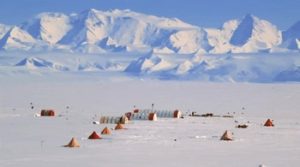James Ross Island is a large island off the southeast side and near the northeastern extremity of the Antarctic Peninsula, from which it is separated by Prince Gustav Channel.
Rising to 1,630 metres (5,350 ft), it is irregularly shaped and extends 40 miles (64 km) in a north–south direction. It was charted in October 1903 by the Swedish Antarctic Expedition under Otto Nordenskiöld, who named it for Sir James Clark Ross, the leader of a British expedition to this area in 1842 that discovered and roughly charted a number of points along the eastern side of the island. The James Ross Island core drilled to bedrock in 2008 by the British Antarctic Survey provided an unprecedented record of soot deposition in the northern Antarctic Peninsula during the past 2000 years and revealed the surprising impacts of Māori burning in New Zealand starting in the late 13th century

In the years 2006/07, a small amount of cargo was pre-deployed to the chosen drilling site. The majority of the cargo and personnel were transported to the site by HMS Endurance, and deployed to the field using the helicopters in early January 2008. A small team of seven on site successfully drilled an ice core from the surface, reaching the bed of the ice at 363 m depth. Following logging of the borehole, the fluid was removed from the hole for reuse on a later project, and to minimize environmental impact. Further operational support was provided during the middle of the season by the BAS Twin Otters flying from Rothera to recover the ice cores to freezers at Rothera, and to assist with rapid uplift at the end of the season in February 2008, when the entire field infrastructure and remaining ice cores were removed from the field, leaving a clear site.
British Drill Camp, at 64°12’ South, 57°41’ West on James Ross Island, Antarctic Peninsula The British Drill Cam, was set and operationl for a brief period of time (2007/2008). The site was removed on Febr. 2008. Even if we have no evidence of any Ham radio activity from there, we at WAP, have decided to insert it on WAP-WADA Directory as WAP-GBR-NEW.
Read more at: The James Ross Island and the Fletcher Promontory ice-core drilling projects | Annals of Glaciology | Cambridge Core
